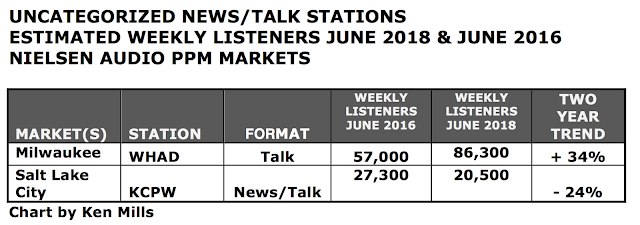 |
| Jarl Mohn at the 2014 PRPD Conference |
Powered
by the growth of estimated weekly listeners to stations in the top twenty radio
markets, the audience for NPR News/Talk stations grew 5% between June 2016 and
June 2018.
Plus, two out of three of the 48 full-time NPR News/Talk stations in
Nielsen Audio PPM markets had more weekly listeners in 2018 compared to 2016.
The
gain in weekly listeners is particularly notable because it was expected that listening
would drop back to pre-election numbers after the November 2016 election. Now,
19 months after the election, it is clear that the majority of NPR News/Talk
stations had more estimated weekly listeners in June 2018 than they had in June
2016, five months prior to the election.
NPR
News/Talk stations in the top twenty markets led the pattern of growth,
increasing their estimated weekly listeners by over 7%. WNYC-FM, New York, led
the gains, growing their weekly listeners by 173,200 new weekly listeners (19%)
in June 2018, compared to June 2016. Other top twenty stations that contributed
double-digit gains included WBUR, WGBH, WABE, KNOW, KERA, KOPB and KJZZ.
Of
the 48 full-time NPR News/Talk stations, 32 (67%) has more estimated weekly
listeners in June 2018 than they did in June 2016.
The number of weekly
listeners to the 48 stations in June 2018 was 12,738,900, compared to
12,110,400 in June 2016.
However,
not all of the 48 stations contributed to the bounty.
WDET, Detroit, lost 80,000 estimated weekly
listeners during the period, down 43%.
Also, WUSF, Tampa lost 62,300 weekly
listeners in 2018, a 29% loss.
Stations
with the largest percentage growth over the period were in smaller PPM markets.
Torey Malatia’s WELH a/k/a Rhode Island Public Radio, increased their number of
estimated weekly from June 2016 to June 2018 by 60%. Also, there were major gains in a market
where NPR News has historically under-performed: KVCR, Riverside/San Bernardino.
The
picture was different for seven stations with dual-formats in PPM markets.
Only
KNKX, Seattle and Georgia Public Broadcasting’s WRAS in Atlanta increased their
number of estimated weekly listeners between June 2016 and June 2018.
The
other five dual-format stations lost weekly listeners led by KCRW with a loss
of 122,700 weekly listeners during the period.
There
are two other news/talk stations that were hard to classify. WHAD in Milwaukee,
part of the Wisconsin Public Radio (WPR) Ideas Network, had a 34% gain in
weekly listeners during the period.
This
is a model that other stations can adopt.
KCPW,
Salt Lake City, remains the outlier. The
community station makes ample use of syndicated programming such as BBC World
Service and CBC from Canada. Perhaps KPCW should concentrate of local versions
of shows like 1A and replicate WPR’s talk menu.









No comments:
Post a Comment